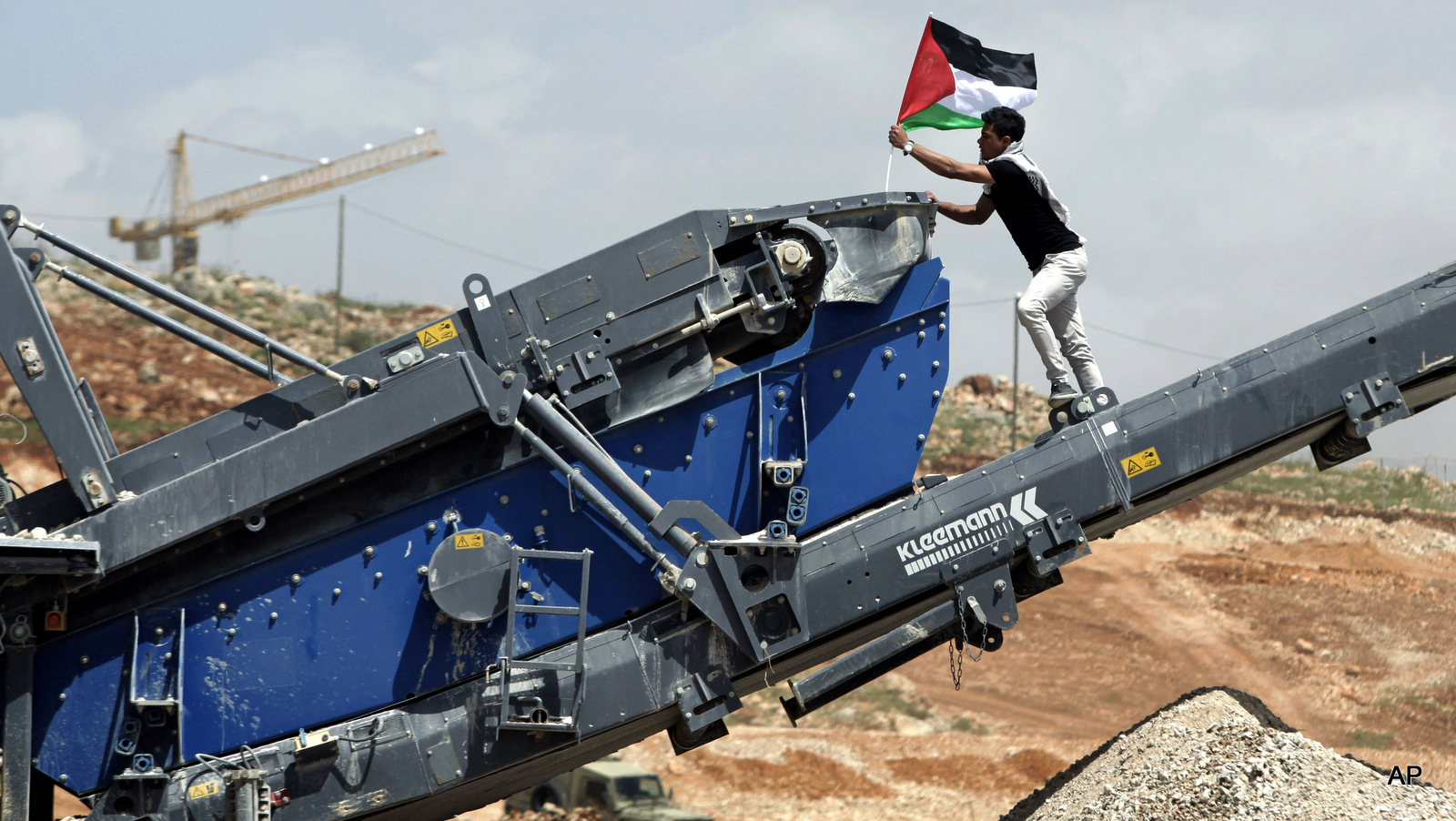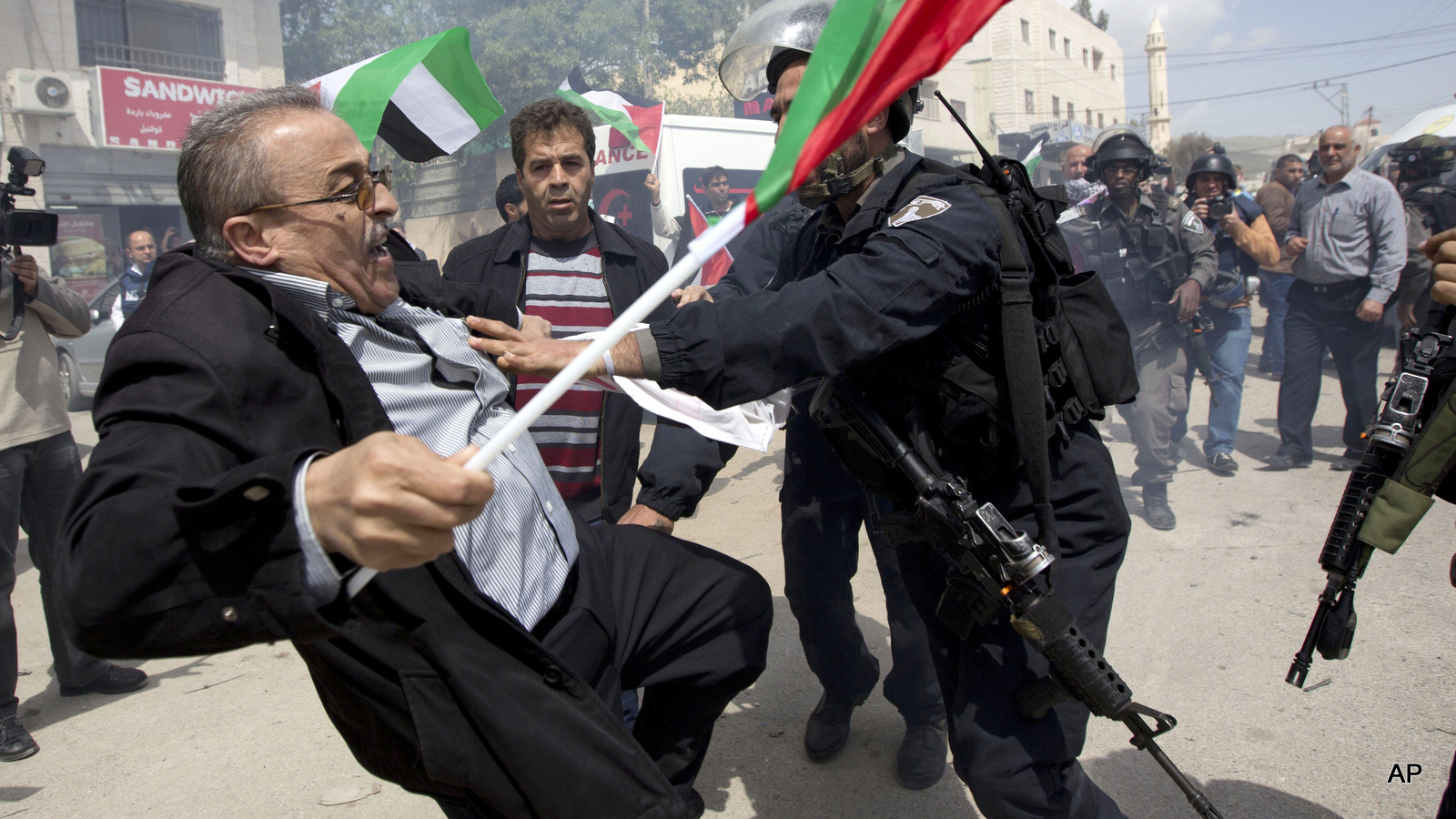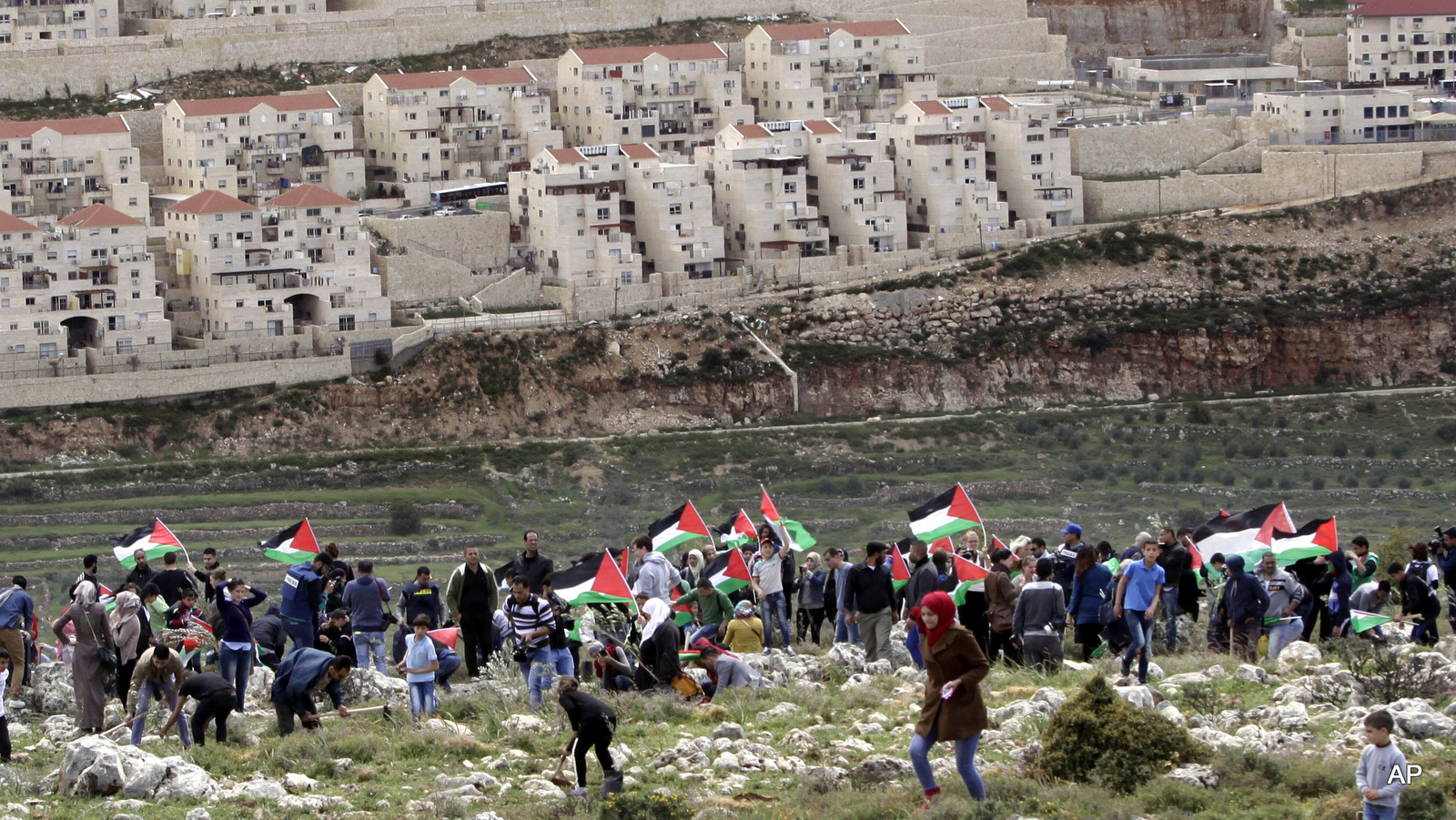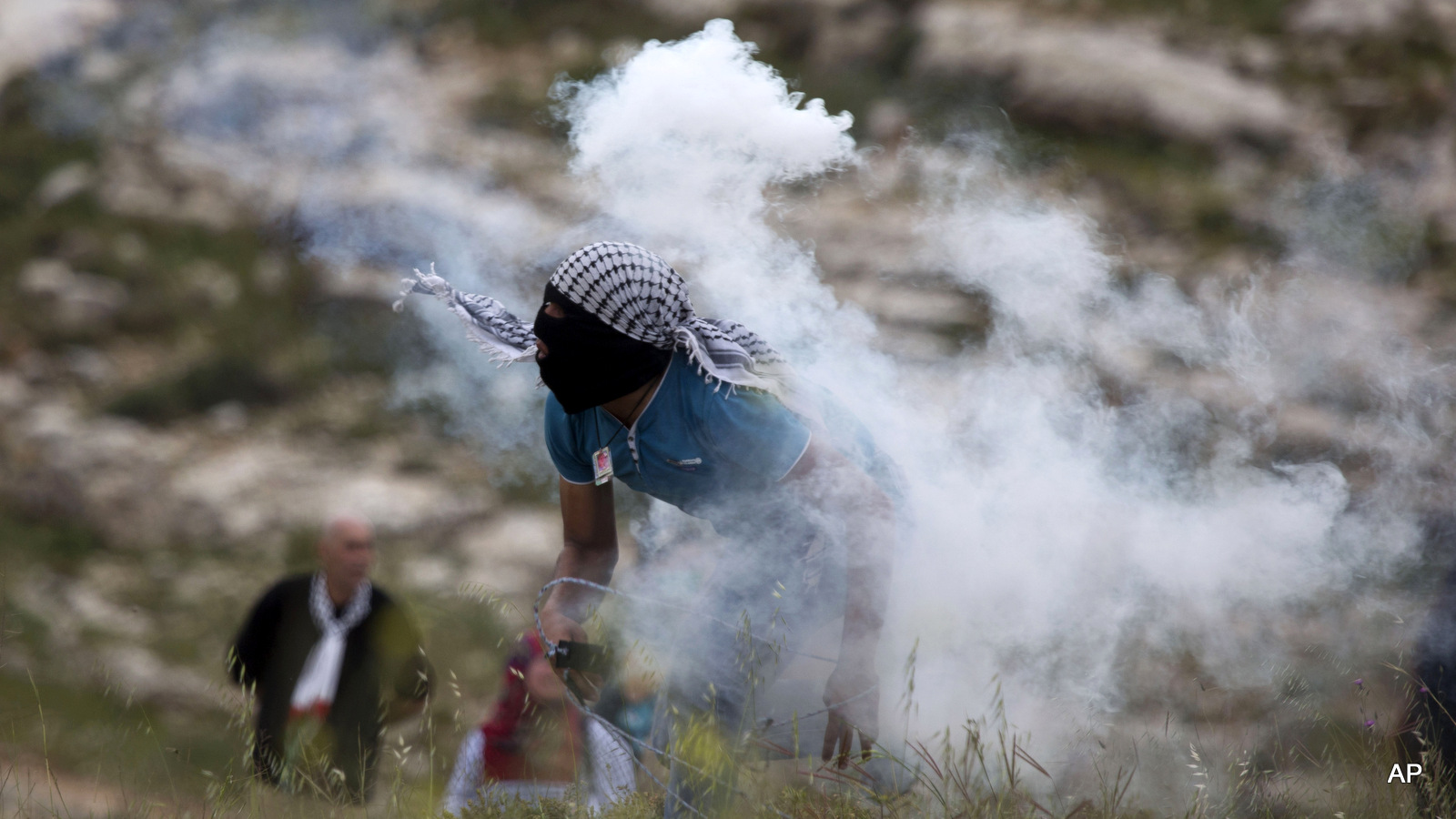 A protester posts a Palestinian flag on Israeli construction equipment at a building site adjacent to the Israeli settlement of Beitar Illit during a protest marking Land Day, in the village of Wadi Fukin, near the West Bank city of Bethlehem, Monday, March 30, 2015. Land Day commemorates riots on March 30, 1976, when six people were killed during a protest by Israeli Arabs whose property was annexed in northern Israel to expand Jewish communities.
A protester posts a Palestinian flag on Israeli construction equipment at a building site adjacent to the Israeli settlement of Beitar Illit during a protest marking Land Day, in the village of Wadi Fukin, near the West Bank city of Bethlehem, Monday, March 30, 2015. Land Day commemorates riots on March 30, 1976, when six people were killed during a protest by Israeli Arabs whose property was annexed in northern Israel to expand Jewish communities.
ABU DIS, West Bank — In March 1976, Israel’s colonization and Judaization of Palestine continued through a state policy that allowed for the expropriation of 2,000 hectares of land in the Galilee region, with the intention of building more Jewish-only settlements and establishing a military training camp there.
The Palestinian response led to mass protests across the territory, which resulted in Israeli soldiers killing six Palestinians and injuring over 100 demonstrators on March 30, 1976. The brutal repression, as well as Israel’s land expropriation, resulted in the annual commemoration of the events of that day, now known as Land Day, across historic Palestine.
Rima Najjar, a Palestinian professor of English at Al-Quds University in Palestine, speaks about Land Day within the context of Palestinian history and collective memory, as well as the ongoing dispossession.
“‘Land Day,’ or ‘Youm al-Ard’ in Arabic, is every day in Palestine,” she said. “Today [April 3] in Abu Dis, for example, people were out protesting the forced expulsion of Palestinian Bedouins from their current locations near Jewish colonial settlements. Abu Dis is a town just behind the illegal apartheid wall southeast of illegally annexed Jerusalem. The wall itself, as well as the surrounding Jewish settlements, have already eaten up a good chunk of Abu Dis land.”
This evocation of a history of dispossession that commenced with the Nakba of 1948 should both transcend the limits of an annual commemoration of a single day and challenge the international complacency in, and acceptance of a two-state compromise.
A day for protests
 Palestinians protester is pushed by Israeli border policemen during a protest marking the Land Day in the West Bank village of Hawara near Nablus, Monday, March 30, 2015.
Palestinians protester is pushed by Israeli border policemen during a protest marking the Land Day in the West Bank village of Hawara near Nablus, Monday, March 30, 2015.
Palestinians in the West Bank demonstrated against Israel’s expansionist policies on March 30. In response, the Israeli military increased its presence at checkpoints. According to Iran’s PressTV, tear gas and stun bombs were used by Israeli soldiers to disrupt this year’s protest.
Meanwhile, demonstrations in East Jerusalem were dispersed by Israeli security forces. According to Palestine News and Information Agency, the official news agency under the PLO Executive Committee, protests also took place in the West Bank, Gaza and Arab towns in Israel, amid reports that the Israeli Planning and Construction Committee had approved further settlement construction in East Jerusalem and issued orders to demolish 14 dwellings in the village of Um al-Kheir.
In Khan Younis, demonstrations calling for Palestinian unity were also met with Israeli violence. Three Palestinians participating in the protests were injured by Israeli soldiers. Israel defended its actions, saying the injured protesters had been instigating a violent riot.
Statements by various Palestinian leaders participating in the commemoration have been adamant about the necessity of stopping Israel’s colonial expansion.
Othman Dweikat from the municipal council of occupied Nablus stated: “This rally is meant in the first place to tell the Israelis that we, the people of Palestine, will always fight for the sake of our land and rights. The world must know that the racist regime grabs our lands to build more settlements.”
Mustafa Barghouti, a leader of the Palestinian National Initiative, defined Land Day as “the day of resistance against occupation; it’s the day of resistance against settlement and resistance for freedom.”
Qais Abdel Karim, of the Democratic Front for the Liberation of Palestine, took an internationalist perspective, stating, “Palestinians all over the world are united today in one voice,” and emphasizing the “inalienable right in our land Palestine.”
Olive trees and the anti-colonial struggle
 Palestinian protesters carry national flags and plant olive trees facing the Israeli settlement of Beitar Illit during a protest marking Land Day, in the village of Wadi Fukin, near the West Bank city of Bethlehem, Monday, March 30, 2015.
Palestinian protesters carry national flags and plant olive trees facing the Israeli settlement of Beitar Illit during a protest marking Land Day, in the village of Wadi Fukin, near the West Bank city of Bethlehem, Monday, March 30, 2015.
Najjar also commented on the Israeli practice of destroying olive trees, which are more than just trees — they’re part of Palestinians’ culture, heritage and livelihood. She pointed to a Ma’an News Agency report that Israeli authorities on April 2 destroyed around 120 olive trees belonging to Palestinian farmers near the village of Salfit in the northern West Bank, bringing the total number of olive trees destroyed to nearly 2,000.
“Both the confiscation of land and the destruction of olive trees are activities that take place daily in the West Bank,” Najjar emphasized.
Although Replant Palestine, an initiative to raise money to replant olive trees in response to Israeli destruction of Palestinians’ livelihood and heritage, failed to reach its funding goals, the project highlights the cycle of violence embarked upon by Israeli settlers and the Israeli government, which seek confiscate supposedly uncultivated land for military purposes.
“In Palestine, the anti-colonial struggle means a struggle to reclaim our land — not just lands and homes confiscated since the 1967 occupation of the West Bank and Gaza and the illegal annexation of East Jerusalem, which have now erased the internationally-recognized border of Israel, the so-called Green Line,” Najjar told MintPress. “The anti-colonial struggle also includes lands and homes illegally seized or destroyed since 1948.”
Najjar also pointed to a report from Badil Resource Center, which says that by the end of 2008 Israel had confiscated or essentially annexed approximately 70 percent of the land in the occupied Palestinian West Bank. Indeed, about 60 percent of this land was already expropriated by the mid-1980s.
Najjar insists that Land Day should also reflect the importance of the Palestinian Right of Return. “Land Day means the return of Palestinian refugees and their descendants to the homeland, as it is their fundamental right under international law. This is not a dream, but a concrete necessity for peace and justice. What’s more, it’s doable,” she said, adding, “People like Salman Abu Sitta from the Palestine Land Society are quietly working on the logistics.”
Dire statistics
 A Palestinian throws back a tear gas canister toward Israeli troops during a protest marking Land Day, in the West Bank village of Nabi Saleh near Ramallah.
A Palestinian throws back a tear gas canister toward Israeli troops during a protest marking Land Day, in the West Bank village of Nabi Saleh near Ramallah.
According to the Palestinian Central Bureau of Statistics (PCBS), Israel has dispossessed Palestinians of 85 percent of historic Palestine. Yet the international community expects Palestinians to negotiate a two-state compromise that clearly supports Israel’s colonization of Palestine. According to the Times of Israel, the European Union is renewing its efforts to kickstart negotiations between Israel and Palestine, while French Foreign Minister Laurent Fabius is seeking to put forth another draft resolution to the U.N. Security Council promoting the two-state compromise.
The press release issued by the PCBS on Land Day includes dire statistics regarding the expropriation of land, dispossession, Judaization and settlement expansion. Between 2000 and 2014, Israel destroyed 1,342 buildings in East Jerusalem, displacing 5,760 Palestinians. Israeli authorities also issued self-demolition orders to 340 Palestinians within the same period.
Exploitation of Palestinian resources is also covered in the press release. Israeli settlers in the West Bank use “more than 50 million m3 of water” to cultivate stolen land. Despite international prohibitions against the exploitation of natural resources, Israel also continues to profit from the usurpation of land, tourism areas, as well as oil and gas exploration, further contributing to Palestinian deprivation.
“International law prohibits Israel from exploiting the natural resources of the occupied territories, but Israel continues regardless and treats Palestinian land as its own,” the PCBS asserts, adding that, “Palestinians are prevent[ed] from utilization (sic) the resources that [are] located in it due to the Israeli militaries and the annexation wall that isolate 10% of the West Bank area.”
Further, it states that Israel’s Operation Protective Edge on Gaza in 2014 completely destroyed 9,000 homes and damaged another 47,000. Additionally, 327 schools, 71 mosques and 29 hospitals were destroyed.
According to The Telegraph, Iran is financially aiding Hamas in its efforts to reconstruct the tunnel network destroyed by Israel during last summer’s assault on Gaza. Burdened by the destruction of dwellings and infrastructure, as well as the blockade which has resulted in severe humanitarian hardships for the Palestinian population in Gaza, including food shortages, Iran is contributing to Palestine’s anti-colonial struggle in a manner that goes beyond the annual remembrance of Land Day.


